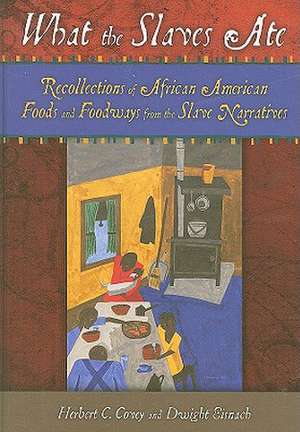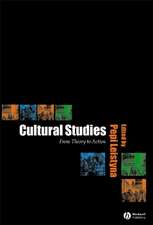What the Slaves Ate: Recollections of African American Foods and Foodways from the Slave Narratives
Autor Herbert C. Covey, Dwight Eisnachen Limba Engleză Hardback – 19 mai 2009 – vârsta până la 17 ani
Preț: 291.01 lei
Preț vechi: 497.36 lei
-41% Nou
Puncte Express: 437
Preț estimativ în valută:
55.69€ • 59.55$ • 46.43£
55.69€ • 59.55$ • 46.43£
Carte tipărită la comandă
Livrare economică 17 aprilie-01 mai
Preluare comenzi: 021 569.72.76
Specificații
ISBN-13: 9780313374975
ISBN-10: 031337497X
Pagini: 328
Ilustrații: 10 bw illus
Dimensiuni: 178 x 254 x 25 mm
Greutate: 0.84 kg
Editura: Bloomsbury Publishing
Colecția Greenwood
Locul publicării:New York, United States
ISBN-10: 031337497X
Pagini: 328
Ilustrații: 10 bw illus
Dimensiuni: 178 x 254 x 25 mm
Greutate: 0.84 kg
Editura: Bloomsbury Publishing
Colecția Greenwood
Locul publicării:New York, United States
Caracteristici
Appendix listing the interviewees who referred to the foods in their narratives, organized by food and by state
Notă biografică
Herbert C. Covey is the author of African American Slave Medicine: Herbal and Non-Herbal Treatments (2007) as well as of numerous books and articles on juvenile gangs and on drug addiction. He has been Vice Chair of the Colorado State Juvenile Parole Board since 1994 and Field Administrator for the Colorado Department of Human Services since 1999.Dwight Eisnach is an independent scholar and editor. He began his career as an investigative reporter and later served the Colorado Department of Human Services for some 25 years, successively as Legislative Liaison, Public Information Officer, and Administrator of the Colorado Juvenile Parole Board.
Cuprins
PrefaceAcknowledgments1. The WPA Narratives and Slave Diets2. Slave Nutrition3. African Roots and Food Traditions4. Slave Cooking and Meals5. Vegetables6. Meat7. Wild Game and Fish8. Dairy9. Grains, Cereals, and Baked Goods10. Fruits, Nuts, and Coffee11. Celebrations, Special Occasions, and the War12. Closing ObservationsAPPENDICES: FOODS IDENTIFIED IN THE WPA NARRATIVESAppendix A: VegetablesAppendix B: MeatsAppendix C: Wild Game: BirdsAppendix D: Wild Game: Fish/ShellfishAppendix E: Wild Game: Reptiles and AmphibiansAppendix F: Wild Game: MammalsAppendix G: DairyAppendix H: GrainsAppendix I: Baked GoodsAppendix J: FruitAppendix K: NutsAppendix L: Sugar/Molasses/SpicesAppendix M: BeveragesAppendix N: General or UnclearBibliographyIndex
Recenzii
This fascinating anthropological documentary excavates 1930s WPA-funded interviews to find the testimony of former slaves on the subject of food's role in daily life. In 12 absorbing, essay-style chapters, Covey (African American Slave Medicine) and independent scholar Eisnach explore how food was used to reinforce power relationships, how slave recipes gradually entered plantation kitchens, and how the Civil War changed entrenched traditions. Fourteen appendixes, categorized by food type, list specific ingredients mentioned by interview subjects and indicate the subject's home state, a record that facilitates awareness of regional customs.'
This book is among the first to explore the diet and cooking behaviors of American slaves through the use of first-person narratives as opposed to archaeological evidence such as slave ship logs, plantation rationing logs and manuals on the treatment of slaves. Covey, an author and Vice Chair of the Colorado State Juvenile Parole Board, has teamed withEisnach, and independent scholar and editor, to collect oral histories handed down from generation to generation and compiled by a WPA narrative project. The authors discuss African traditions and roots that influenced food consumption and break down the slaves' diet according to food category.
.contribute greatly to our knowledge of African-American diet and cuisine, a subject often clouded by myth, misinformation and ignorance. .This book helps us understand the use of food as a control mechanism, through rationing, denial and timing of the supply as well as the effect of these issues on nutrition and health. Researchers tell the story of how the people they enslaved repurposed what was available to create new cuisines, often supplementing meager supplies by farming, fishing and hunting. Many recipes are included, and appendices list more than 300 foods or dishes found as researchers examined all 2,200 narratives recorded by the WPA.
Highly recommended for high school, community college, college and public libraries.
This book is among the first to explore the diet and cooking behaviors of American slaves through the use of first-person narratives as opposed to archaeological evidence such as slave ship logs, plantation rationing logs and manuals on the treatment of slaves. Covey, an author and Vice Chair of the Colorado State Juvenile Parole Board, has teamed withEisnach, and independent scholar and editor, to collect oral histories handed down from generation to generation and compiled by a WPA narrative project. The authors discuss African traditions and roots that influenced food consumption and break down the slaves' diet according to food category.
.contribute greatly to our knowledge of African-American diet and cuisine, a subject often clouded by myth, misinformation and ignorance. .This book helps us understand the use of food as a control mechanism, through rationing, denial and timing of the supply as well as the effect of these issues on nutrition and health. Researchers tell the story of how the people they enslaved repurposed what was available to create new cuisines, often supplementing meager supplies by farming, fishing and hunting. Many recipes are included, and appendices list more than 300 foods or dishes found as researchers examined all 2,200 narratives recorded by the WPA.
Highly recommended for high school, community college, college and public libraries.










